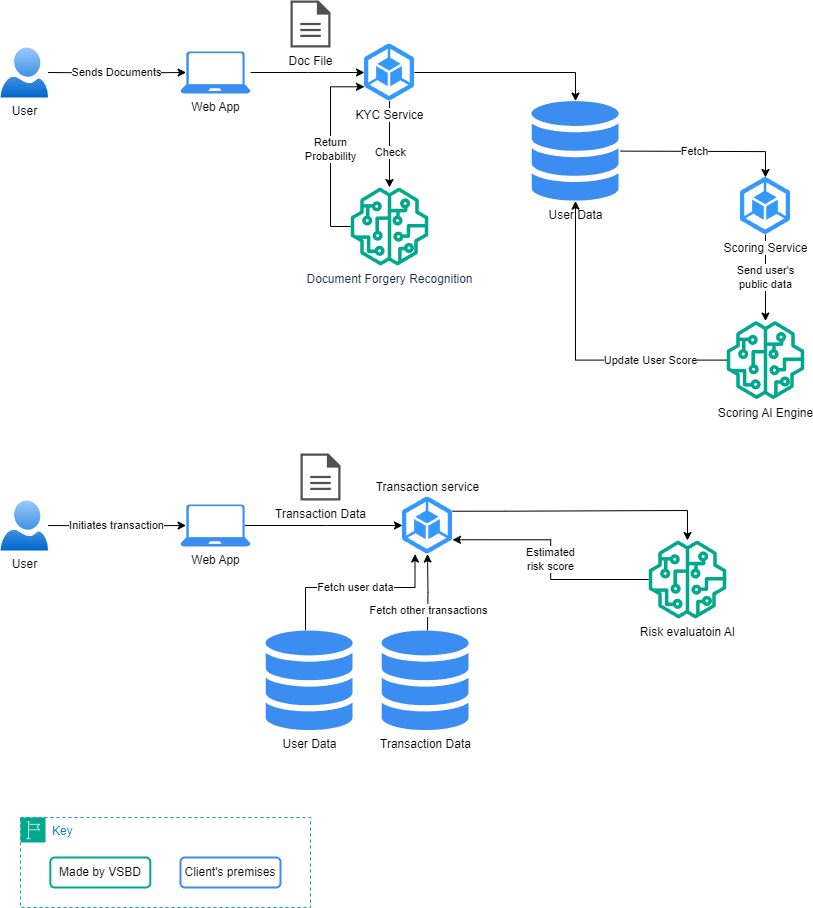Risk Assessment Assistant
AI based risk profile evaluation within KYC process

The Client
One of the few world’s renowned financial institutions headquartered in the US. Operating tens to hundreds of millions of customers worldwide and having yearly financial operations totalling in trillions of dollars the question of security is beyond negotiation.
The Problem
While financial operations and securities are the main essence of their business, the client constantly continues to improve its security system. This time they decided to augment their processes with AI solutions. The idea was to provide yet another point to risk evaluation at various stages.
We focused on three main use cases. The first one was a typical KYC routine. While document provision itself was not a problem, the client needed an automated solution to identify when the picture sent has been tampered with.
After the KYC the client typically makes a risk profile for a user based on the publicly available information (social networks, news, articles…). To improve the scoring process the client decided to incorporate Machine Learning into the procedure. This is where our team stepped in.
And lastly when it comes to the financial operations the client wants to understand whether or not they are related to any type of illegal activity.
Challenges
Not a ‘Yes or No’
problem
The seemingly simple questions would receive the answers in a manner of probabilities.
Isolated use cases but related scoring
While all the use cases are independent, the operations risk is also evaluated based on the score obtained from previous steps.
Unstructured data
The knowledge about the user is hard to form in a unified structure. There are text, pictures and maybe even video.
The Solution
Our team has built a couple of models to address each of the problems arised. For document forgery we created a typical CNN model and trained it to recognize various image artifacts such as photoshop traces, noise, unnatural transitions etc.
The trickiest part was about the data processing. There was a different model per each data format: text, audio, video, photo… They all shared the same idea: the media was analyzed to find the triggering content and score it accordingly awarding positive and negative points. Finally the scores were passed to the client’s system to calculate the overall metric.
Transactional risk assessment narrowed down to a typical reduction problem, but required numerous input variables, such as user’s score, past transactions time, amount and their score, recipient’s scores and many more. But although it required a lot of input data, the ML model was relatively simple as it dealt with simple yet large data sets.
Obstacles
Content analysis should take into account its relativity to the user. The system might find content associated with a user (published in their social network) while the content itself is unrelated to them (like a 3rd party video). In this case the scoring system should not grade such a content. This was achieved using an additional ML model before passing it to the evaluation service. The first model decided whether or not the content is related to a user, and the next one tried to grade it.
The Value
The overall security of our client was boosted by adding another level of automation in their processes and giving the new tools for evaluation at the same time. The provided solution allowed to revise all the scores of the client’s users. It reduced the amount of false positive identification of risky transactions and helped discover some new signs of insecure operations.
VSBD - Software Development
More Postsa b c d e f g h i j k l m n o - Do not remove from template!!! it is important to support different fonts
All Rights Reserved | VSBD




